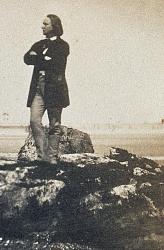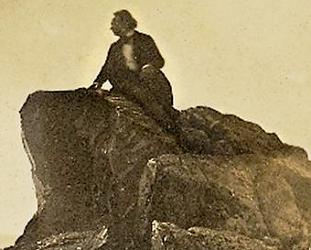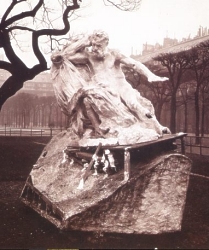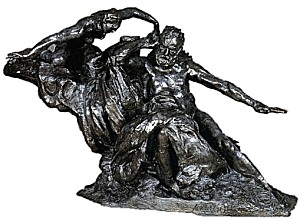Rodin Works: Monument to victor hugo |
|
Rodin was introduced to the writer by his friend and
journalist Edmond Bazire. Since Hugo - another portrait of him having been
made shortly before -, In 1889, Rodin was invited to create a 'Monument to Victor Hugo', to be positioned at the north transept of the Panthéon in a large setting comprising 100 sculptures. The project had been conceived of by Edward Lockroy, to commemorate the great men of French history. Like the Calais Monument, it should help to restore national pride, after the shameful intermezzo of Bonapartism and the defeat of the Franco-Prussian War provoked by Bismarck. It was Rodin's second commission for a monument by the
State. Rodin's draft shows the nude poet, sitting on a rock symbolizing
the Island of Guernsey, where Hugo had spent part of his exile years. The
figure of the poet was surrounded by three Muses, representing Youth,
Maturity and Old Age; alternatively, the Muses were each associated with a
Hugo work: 'Les Orientales', 'Les Châtiments' and 'Meditation'. As Rodin started to give more room to these Muses - originally closely flocked together behind Hugo's back - and his design thus was developing in a horizontal rather than vertical direction, the committee concluded Rodin's proposal would not harmonize with the 'Monument to Mirabeau' by Injalbert, with which it should be matched. A painted facsimile presented in Summer 1890 was condemned for its "lack of clarity and its confused silhouette". On 19 June 1890, Rodin was asked to develop a standing Victor Hugo for the Panthéon instead, in balance with Injalbert's erect figure; for the seated Victor Hugo, a worthy outside location should be found. For the Panthéon, Rodin now created 'The Apotheosis of Victor Hugo', which was completed by 1891 - but never installed there and only cast as a maquette. At the bottom of the column, we recognize the three 'Sirens'. The rejection of the seated version offered Rodin the opportunity to re-work his horizontal compostion once more. The sculptor even travelled to Guernsy to taste the air Hugo had breathed there, and kept adapting the figures of the Muses. The character of 'Iris' was introduced, allegedly to represent Glory. Simultaneously, the sculptor created a series of private studies, representing male artists inpired, caressed or comforted by female characters: 'The Genius and Pity' (1895) 'The Poet and Love' (1896), 'The Sculptor and his Muse' (1895-97), 'The Man and his Thought' (1896). The rejection of his first design of the 'Monument to Victor Hugo', the harsh critique of his 'Monument to Claude Lorraine', the difficulties regarding the execution and installment of 'The Burghers of Calais', and last but not least the open crisis in his relationship with Camille Claudel must have urged Rodin to deal with these themes intensively during these years. The Jardin du Luxembourg was mentioned as an
appropriate location now. Rodin wanted the 'Monument' to be carved in
marble, with its translucent, soft contours, so that the figure of the
poet would appear "veiled in fog".
Finally, a marble sculpture of the Poet, resting on the rocks of the island of Guernsy, without any Muses, was carved to be exhibited as the centerpiece of the Salon of 1901. With the support of Dujardin-Beaumetz, this marble version was finally placed in the gardens of the Palais-Royal on a pedestal of uneven stone slabs in 1909, where it stayed till 1933; later, it was removed to the Musée Rodin. Rodin's Project as an execution of Hugo's self-erected monument The two photos above (left and middle), made in 1853 during Hugo's exile by his son Charles, must have been familiar to Rodin; Hugo had deliberately directed their shooting as an essential part of his poetic and political message and published them in order to project his own myth. As a consequence, by the time Rodin designed the first version of his 'Monument', the image of the visionary poet, immune to political corruption, listening to the wind, the sea and the voice of the stars (like in Hugo's poem 'Stella') while resting on the Guernsy rocks as his pedestal, already had become a visual commonplace: Le poète est également celui qui éclaire les peuples par la parole, ici la poésie dont le lyrisme s’accorde avec celui des photographies. Ainsi Hugo a-t-il lui-même et consciemment façonné son propre mythe. Dans les décennies suivantes, illustrateurs et caricaturistes réutiliseront l’image de Hugo sur son « piédestal », véritable statue vivante. [Stéphanie CABANNE - read the full article here] In this sense, Rodin's composition was not solely based on his own inspiration, but to a certain degree the execution of the poet's own imagined monument, in clay, plaster and marble. The revival of a forgotten Design Rodin's 1897 model sank into oblivion. Only in 1950, when Victor Hugo´s 150th anniversary, the year 1952, was nearing, the City of Paris, looking for a suitable monument, thought of Rodin's attempts again, and commissioned a bronze cast from a model Ruth Butler describes as a: "... three-figure plaster in the Musée Rodin, a work that had so been out of view for the past fifty years that it was neither mentioned nor illustrated in the official catalogue of the museum, a catalogue considered as nearly complete"
|
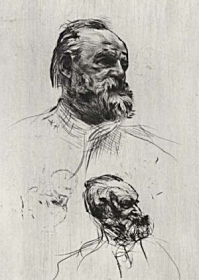 Already
in 1883 Rodin received the commission for a portrait bust of the writer
Victor Hugo (1802-1885). By that time, the author of 'The Hunchback of
Notre Dame' (1831) and 'Les Misérables' (1845-1862) had reached the
status of a national hero. In 1851, Hugo had tried to prevent the coup
d´état by Louis Napoleon, who reigned as Napoleon III till 1870.
During this period, Hugo had stayed in exile.
Already
in 1883 Rodin received the commission for a portrait bust of the writer
Victor Hugo (1802-1885). By that time, the author of 'The Hunchback of
Notre Dame' (1831) and 'Les Misérables' (1845-1862) had reached the
status of a national hero. In 1851, Hugo had tried to prevent the coup
d´état by Louis Napoleon, who reigned as Napoleon III till 1870.
During this period, Hugo had stayed in exile.
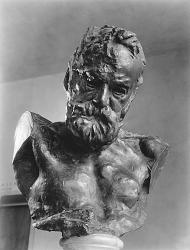 didn't
want to sit as a model, the sculptor had to rely on observations and
hastily-made drawings, produced during a four-month period. Rodin
scribbled sketches on cigarette paper, modeled a clay portrait while
standing on the balcony of Hugo's room.
The marble bust was executed in 1883, two years before Victor Hugo
died.
didn't
want to sit as a model, the sculptor had to rely on observations and
hastily-made drawings, produced during a four-month period. Rodin
scribbled sketches on cigarette paper, modeled a clay portrait while
standing on the balcony of Hugo's room.
The marble bust was executed in 1883, two years before Victor Hugo
died.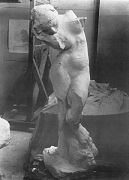
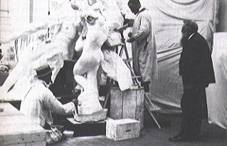
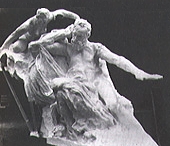 In
1897, an enlarged plaster version was presented in the Salon of the
Societé Nationale des Beaux-arts, occupying the place of honor
under the central dome of the hall. This version showed only two Muses -
the 'Tragic Muse' and 'Meditation', while 'Iris' had been omitted.
The enlargement by LeBossé still looked very provisory: Hugo's arm was
supported by a metal pipe, his shoulder ripped, the armature of the
In
1897, an enlarged plaster version was presented in the Salon of the
Societé Nationale des Beaux-arts, occupying the place of honor
under the central dome of the hall. This version showed only two Muses -
the 'Tragic Muse' and 'Meditation', while 'Iris' had been omitted.
The enlargement by LeBossé still looked very provisory: Hugo's arm was
supported by a metal pipe, his shoulder ripped, the armature of the 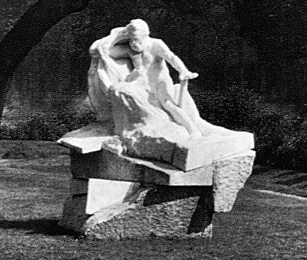 "This
work, in its present state, is nothing more than a piecemeal, incoherent
study, on which it would be premature to pass judgement. The catalogue is
willing to forewarn us that, in this collossal sketch, an arm of a female
figure is incomplete; it is an optimistic catalogue. Oh! If there were
only an arm incomplete! Another arm, it is true, is long beyond measure;
but is that compensation?"
"This
work, in its present state, is nothing more than a piecemeal, incoherent
study, on which it would be premature to pass judgement. The catalogue is
willing to forewarn us that, in this collossal sketch, an arm of a female
figure is incomplete; it is an optimistic catalogue. Oh! If there were
only an arm incomplete! Another arm, it is true, is long beyond measure;
but is that compensation?"
